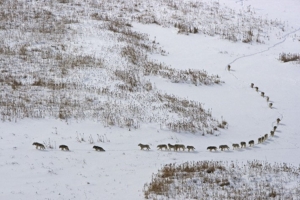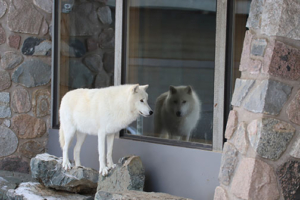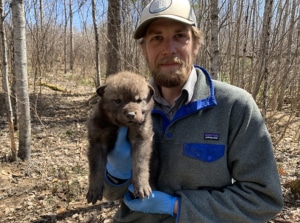Over the years, the International Wolf Center has worked hard to compile a growing number of articles to dispel myths, explain wolf behavior and give context to long-standing debates. This Facts vs. Fiction page puts all of those articles together on one page.
Myth busting
Caption attached to photo of wolves traveling through snow as a pack is false

Photo by Chadden Hunter, BBC.
This photo was taken in 2011 at Wood Buffalo National Park by Chadden Hunter for a BBC series called Frozen Planet. The caption, which does not accurately interpret the behavior in the picture, was added at a later date by an unknown source.
What is surplus killing, and why do wolves do it?

A screenshot of a National Geographic post from March 25, 2016
This article on surplus killing aims to set the record straight on this often misunderstood phenomenon.
We thank all of the biologists whose work has shed important light on this behavior.
Science Non-Fiction
An Overview: The USGS Superior National Forest Wolf and Deer Research Project
The Wolf and Deer Research Project in the Superior National Forest (SNF) of northeastern Minnesota began in 1966 and continued into 2022 under the auspices of several organizations and agencies, most recently the U.S. Geological Survey. Its primary objective has been to determine and follow the annual wolf density in a 2,060 square-km (almost 800 square-mile) part of the east-central SNF and assess the causes of its trajectory over a long period.
This research began in February1966 when Dave Mech, on his personal time, began examining and gathering specimens from wolf-killed deer in the east-central part of the SNF.
Ambassador Wolves Participate in Research Studies
 The International Wolf Center wolves are famous for providing unique educational opportunities to visitors in Ely and to people online around the globe. Less known are the contributions these wolves make to scientific research. Recently the Center’s Exhibit Pack and Retired Pack were subjects of behavioral and acoustic research projects.
The International Wolf Center wolves are famous for providing unique educational opportunities to visitors in Ely and to people online around the globe. Less known are the contributions these wolves make to scientific research. Recently the Center’s Exhibit Pack and Retired Pack were subjects of behavioral and acoustic research projects.
Are wolves dangerous to humans?
Are wolves dangerous to humans? According to the latest research, which studied worldwide data from 2002 to 2020, the risks associated with a wolf attack are “above zero, but far too low to calculate.”
Do wolves need water?
Have you ever stopped to consider whether or not wolves need water to drink? Or how wolves (and dogs) drink water? If so, this is the post for you!
Arctic wolves have unique adaptation to prevent cold injury to their paws
It’s a fair question: How do arctic wolves not get cold-related injuries to their paws as they endure harsh winters on Ellesmere Island or in northern Canada?
The simple answer, according to biologists, is that instead of blood flow being reduced to their feet in the cold temperatures, the opposite occurs. Blood flow in fact increases to their feet.
This is one key adaptation that allows arctic wolves to thrive in their frigid environment.
What’s a lone wolf? And why do wolves disperse?
The term “lone wolf” is often used in popular culture today. But where did the term lone wolf come from? And what does it mean?
Put simply, the term “lone wolf” describes a pack wolf that happens to temporarily be traveling alone, which is often the case during summer, or one that has dispersed from its natal pack. The latter wolves set off by themselves.
Why?
How did wolves become dogs?
Dog lovers, whether they own a chihuahua or a Labrador retriever, all eventually ask one question: How is it that this domesticated dog came from wolves?
That’s not an easy question to answer, but there are two main hypotheses surrounding the topic and both were discussed in a 2021 paper written by David Mech and Luc A. A. Janssens.
Working as a wolf biologist
Memories Of Wolves From The Superior National Forest Wolf-Deer Study
Stories told by L. David Mech
Written by Cree Bradley
 Over fifty years of wolf data were collected through Minnesota’s Superior National Forest (SNF) Wolf-Deer Study. This achievement built a wealth of understanding about wolf-prey relationships, population dynamics and scent-marking as it developed and refined methodology adapted and used by researchers around the world.
Over fifty years of wolf data were collected through Minnesota’s Superior National Forest (SNF) Wolf-Deer Study. This achievement built a wealth of understanding about wolf-prey relationships, population dynamics and scent-marking as it developed and refined methodology adapted and used by researchers around the world.
Nearly equal in measure to this scientific legacy, for Dr. L. David Mech – or Dave – who initiated the study, are the enduring memories garnered from 1966-2022 through his experiences with the wolves themselves. Some wolves taught Dave valuable lessons about how to trap, how to improve trapping, and whether ever to trap again. Other wolves possessed a curiosity or some behavior that was intriguing or entertaining to behold. And yet another, Wolf 2407, captivated Dave’s imagination and earned his gratitude for all that her life contributed to the study.
Just as the data were gathered, so too, were the stories – endearing memories of specific wolves, as told by Dave himself:
Dave Catches His First Wolf
Near the start of the SNF study in 1968, Dave hired trapper Bob Himes to provide expertise in catching wolves to be radio-collared. The first wolf Bob and Dave caught, using Bob’s trapping leadership, was Wolf 1051, captured along the Powwow Lake Road. Click here to read the full story.
What does it take to become a wolf biologist?

Wolf biologists are the individuals who discover and uncover the truth about wolves, and in turn, use what they know to better understand, conserve, and manage wolves. But how does one become a wolf biologist? What path does a young person take to end up flying over the Northwoods counting the number of wolves in a pack or putting a GPS collar on a wild wolf?

The International Wolf Center uses science-based education to teach and inspire the world about wolves, their ecology, and the wolf-human relationship.
